Blog

The Benefits and Pitfalls of the Bring Your Own Device Movement
IT hardware can be a huge outlay for many small businesses. When you combine that with the fact that many workers now either only come into the office occasionally or work from home full-time you can see why the ‘Bring Your Own Device’ movement has flourished.
The Pros
‘Bring Your Own Device’ means that employees are encouraged to use their own hardware such as laptops, mobile phones and tablets for business. Many employees prefer this scenario as they don’t have to carry two devices with them, for example their business and personal mobile phone, and there is no learning curve as they find their way around a new laptop or tablet.
For the company the benefits are twofold. First, productivity is improved because, as highlighted above, workers are using equipment they are familiar with and therefore don’t need additional training or time to acclimatise to new technology.
Second, costs are lower because it is only software which the company needs to pay for and not hardware. Businesses also need fewer support staff to manage internal IT systems. It is also now possible to add alternative business communication methods to personal devices so you and your employees don’t even need to worry about expense claims for business calls as they can be kept entirely separate.
The Cons
If your employees use their own devices there are areas which will need careful consideration.
First, the hardware itself will need to be fairly up to date, especially if it has to run several memory-hungry applications. Therefore, your IT staff will need to take this into account when seeing if a device is suitable.
Second, cyber security is an issue which needs to be taken seriously. Anti-virus software should be installed on every device and this should be updated and scans run regularly. Firewalls and VPN can also be utilised by staff to protect your company data. If you don’t have the in-house capacity to check whether your security is adequate you can always outsource your IT Support. This is a cost effective way to keep up to date but with none of the overheads involved with employing permanent IT staff.
The other area which should be assessed is data protection. Your staff will probably hold business emails; contracts; and sensitive and financial data on their laptops and mobiles. Because these devices are kept at home you will have less control over whether they are adequately password protected and kept in a secure manner. Data security is a highly regulated area, and the government has had concerns over ‘Bring Your Own Device’. Thus the Information Commissioner published a series of guidelines about the concept and it is wise to examine these to help you recognise your potential risk and therefore do what you can to mitigate your exposure. If your business is one which holds a great deal of highly sensitive data, such as financial details, personal information or medical records, then ‘Bring Your Own Device’ is probably not the right option for you.
Ultimately your decision as to whether you should encourage staff to use their own devices comes down to the type of business you run; the views of your staff; and whether you can strike a balance between security and cost savings. If you implement steps to protect data; keep your systems secure; and if your staff are happy to use their own hardware, then the reduced expenses and productivity boost should outweigh the potential drawbacks.



Comments